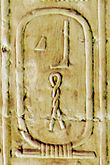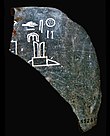Qaa
| Names of Qaa | ||||||||||||||||||||||||||||
|---|---|---|---|---|---|---|---|---|---|---|---|---|---|---|---|---|---|---|---|---|---|---|---|---|---|---|---|---|
 Grave stele of Qaa from Abydos ; Museum of Archeology and Anthropology at the University of Pennsylvania, Philadelphia
|
||||||||||||||||||||||||||||
| Horus name |
Q3j-ˁ The one with a high arm |
|||||||||||||||||||||||||||
| Sideline |
Nbtj-sn For kissing the two mistresses |
|||||||||||||||||||||||||||
| Proper name |
Nsw.t-btj Q3jˁ King of Upper and Lower Egypt, Qa'a |
|||||||||||||||||||||||||||
| Royal Papyrus Turin (No. II./19) |
(Qe) beh (Q) bḥ (The one from) the north |
|||||||||||||||||||||||||||
| List of kings of Abydos (Seti I) (No. 8) |
Qbḥ |
|||||||||||||||||||||||||||
| Saqqara King List (No.2) |
Qbḥw (The one from) the north |
|||||||||||||||||||||||||||
| Greek Manetho variants: |
Africanus : Bieneches Eusebius : Oubienthis Eusebius, AV : Vibenthis |
|||||||||||||||||||||||||||
Qaa (aka Hor-qa-a ) is the Horus name of an ancient Egyptian king ( Pharaoh ) of the 1st Dynasty ( early Dynasty ), who lived around 2870/50 BC. Ruled.
There is disagreement about the actual duration of the reign, in the Turin royal papyrus Qaa is assigned 63 years, while Manetho ascribes him only 26 years. According to more recent findings based on vessel inscriptions as well as evaluations and reconstructions of the Palermo stone, Qaa may have ruled for about 33 years.
family
It is not clear who Qaa's father is. It is believed, however, that Semerchet (his predecessor) or Anedjib could be his father. According to Manetho, he is the son of Semerchet.
government

Before he took office, Peter Kaplony identified Qaa as the official Qaa-nebti, who had the functional title of Sem . The duties of the Sem priest , who was only occupied in the 5th dynasty , were still carried out by the eldest king's son and successor himself at that time. For these reasons, Kaplony suspects that Qaa ascended the throne as crown prince and eldest son through the natural successor rite.
Qaa seems to have ruled for a relatively long time. His second Sedfest ( Heb-sed ) is documented on stone bowls from Saqqara . In Saqqara several mastabas (S3500, S3505, S3120) date from his reign. The first years of reign are preserved on the Cairen fragment of the Palermostein , but this mostly only records religious celebrations. Some annual tablets of the ruler are known, one of which mentions the foundation of a building called qau-netjeru .
A mastaba in Saqqara (S3505) belongs to the official Merka . For the first time, a mortuary temple is in front of this mastaba , with remnants of the painting still visible. Other high officials under Qaa are a certain Henuka , who was also in office under Semerchet, as well as Neferef and Sabef , who were buried in Abydos. There was a decorated stele by Sabef there. Under Qaa the important office of a Tjati is attested for the first time , but his name has not been passed down.
Transition from 1st to 2nd dynasty
There are signs that the end of his reign was not entirely unproblematic. The name of an otherwise little-attested ruler, Seneferka, was found in the grave of the official Merka mentioned above . The name of a certain king, "Vogel" , was found on other vessel fragments that date around this time . Both rulers do not appear in later king lists . It is believed that these rulers fought for the throne after the death of Qaa and Hetepsechemui , first ruler of the 2nd Dynasty , had to forcibly end the situation, whereupon a new dynasty began. In the case of Seneferka's name, however, it has also been assumed that it could have been a second Horus name from Qaa, which Qaa only had for a very short time.
tomb
From Qaa, the last king of the 1st dynasty, we know the grave in Abydos (grave Q), which is about 30 by 23 meters. It consisted of an underground burial chamber to which a staircase led down. There were four pantries next to the stairs. The grave was robbed. A remarkable find is an ivory stick , probably from a game in which a tied Asian man is depicted, as the inscription indicates. In addition to the usual vessel seals with his name, two steles were found in his Abydos tomb . They are now in the museums of Cairo and Pennsylvania (see picture). The custom of burying the royal servants with the death of the king subsided under the reign of Qaa (only 26 side graves) and ceased entirely in the 2nd dynasty.
literature
- Jürgen von Beckerath: Chronology of the pharaonic Egypt. von Zabern, Mainz 1997, ISBN 3-8053-2310-7 , pp. 167-173.
- Walter B. Emery : Egypt, History and Culture of the Early Period, 3200-2800 BC Chr. Goldmann, Munich 1964.
- Eva-Maria Engel: The tomb of Qa'a: architecture and inventory. (= Archaeological publications of the German Archaeological Institute. Volume 100). Harrassowitz, Wiesbaden 2017, ISBN 978-3447108768 .
- Martin von Falck, Susanne Martinssen-von Falck: The great pharaohs. From the early days to the Middle Kingdom. Marix, Wiesbaden 2015, ISBN 978-3737409766 , pp. 50-53.
- Wolfgang Helck : Investigations into the thinite age. (= Egyptological treatises. Vol. 45). Harrassowitz, Wiesbaden 1987, ISBN 3-447-02677-4 .
- Jochem Kahl : Inscriptional Evidence for the Relative Chronology of Dyn. 0-2. In: Erik Hornung, Rolf Krauss, David A. Warburton (eds.): Ancient Egyptian Chronology (= Handbook of Oriental studies. Section One. The Near and Middle East. Volume 83). Brill, Leiden / Boston 2006, ISBN 978-90-04-11385-5 , pp. 94-115 ( online ).
- Peter Kaplony : Inscriptions of the early Egyptian period. Harrassowitz, Wiesbaden 1963, Volume III, ISBN 3-447-00052-X .
- Jean Leclant / Gisele Clerc: Fouilles et travaux en Egypte et au Soudan, 1991-1992. In: Orientalia 62, Rom 1993, pp. 175-295.
- WM Flinders Petrie , Francis Llewellyn Griffith : The royal tombs of the first dynasty. 1900. Part 1. (= Memoir of the Egypt Exploration Fund. Volume 18, ISSN 0307-5109 ). Egypt Exploration Fund, London 1900, digitized , p. 9 (3.12).
- WM Flinders Petrie, Francis Llewellyn Griffith: The royal tombs of the earliest dynasties. 1901. Part II (= Memoir of the Egypt Exploration Fund. Volume 21, ZDB -ID 988141-4 ). Egypt Exploration Fund, London 1901, p. 12 (6).
- Thomas Schneider : Lexicon of the Pharaohs. Albatros, Düsseldorf 2002, ISBN 3-491-96053-3 , p. 226.
- Toby AH Wilkinson : Early Dynastic Egypt. Routledge, London / New York 1999, ISBN 0-415-18633-1 .
Web links
Remarks
- ↑ a b c Length of government: 26 years.
Individual evidence
- ↑ a b c Hermann Ranke : The ancient Egyptian personal names. Vol.?, Augustin, Glückstadt et al. 1935, 1952, 1977, p. 319, online as PDF .
- ^ Alan H. Gardiner: The royal canon of Turin . Griffith Institute, Oxford 1997, ISBN 0-900416-48-3 , illustration 1; The presentation of the entry in the Turin papyrus, which differs from the usual syntax for hieroboxes, is based on the fact that open cartridges were used in the hieratic . The alternating time-missing-time presence of certain name elements is due to material damage in the papyrus.
- ↑ Elmar Edel : On the inscriptions on the seasonal reliefs of the "World Chamber" from the solar sanctuary of Niuserre. In: News from the Academy of Sciences in Göttingen, No. 8 . Vandenhoeck & Ruprecht, Göttingen 1961, p. 112.
- ↑ Year numbers according to Schneider: Lexicon of the Pharaohs.
- ↑ Turin kinglist. Columns II, 11 to III, 26 / 27. ( Memento from January 12, 2007 in the web archive archive.today ) On: ancient-egypt.org
- ↑ a b Wolfgang Helck: Investigations on the thinite age. Wiesbaden 1987, p. 124.
- ↑ Peter Kaplony: The inscriptions of the early Egyptian times. Vol. 1, Harrassowitz, Wiesbaden 1963, p. 637.
- ^ Pierre Lacau, JP Lauer: La Pyramide a Degeres IV, Inscriptions Gravees sur les Vases. Cairo 1959, p. 12, plate 8, no.41.
- ↑ Flinders Petrie: The Royal Tombs of the first dynasty. 1900. Part I. London 1900, panel XVII, 28.
- ↑ Flinders Petrie: The Royal Tombs of the first dynasty. 1900. Part I. London 1900, panel XXX, XXXI, 48.
- ↑ on a seal impression of the Qaa from the Saqqara grave S3504, WB Emery: Great Tombs of the First Dynasty II. London 1954, p. 127, Fig. 200.
- ^ Wilkinson: Early Dynastic Egypt. London / New York 1999, p. 82.
- ↑ Flinders Petrie: The Royal Tombs of the first dynasty. 1900. Part I. London 1900, panel XII, 12-13; XVII, 30.
- ↑ Flinders Petrie: The Royal Tombs of the first dynasty. 1900. Part I. London 1900, pp. 14-16, panel LX.
| predecessor | Office | successor |
|---|---|---|
| Semerchet |
King of Egypt 1st Dynasty (end) |
Hetepsechemui |
| personal data | |
|---|---|
| SURNAME | Qaa |
| ALTERNATIVE NAMES | Hor-qa-a |
| BRIEF DESCRIPTION | ancient Egyptian king of the 1st dynasty |
| DATE OF BIRTH | around 2853 BC Chr. |
| DATE OF DEATH | around 2828 BC Chr. |


